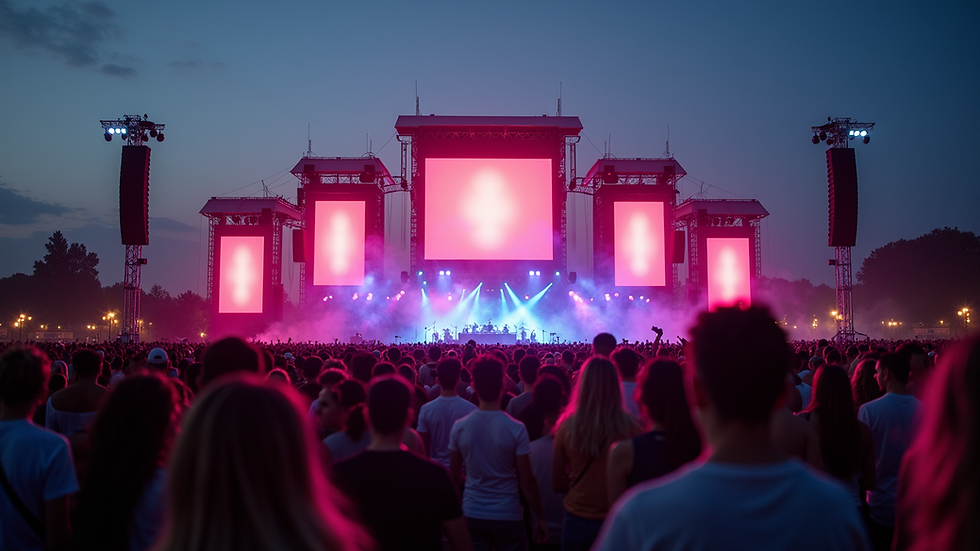Choosing the Best LED Screen Solutions
- GDS Sound & Light
- Sep 26
- 4 min read
When planning an event, one of the most important elements to consider is the visual experience. A high-quality LED screen setup can transform any event, making it more engaging and memorable. Whether it’s a corporate conference, a music festival, or a sports event, the right screen setup ensures clear visibility and vibrant displays for all attendees. This guide will help you understand how to choose the best event LED screen setups to meet your specific needs.
Understanding Event LED Screen Setups
Event LED screen setups vary widely depending on the type of event, venue size, and audience expectations. These setups include different screen sizes, resolutions, and configurations. Knowing the basics will help you make an informed decision.
Screen Size: Larger screens are ideal for big venues or outdoor events, while smaller screens work well for intimate indoor settings.
Resolution: Higher resolution screens provide sharper images, which is crucial for displaying detailed content like videos or presentations.
Configuration: Screens can be arranged in single panels, video walls, or curved setups depending on the event’s design and space.
For example, a music festival might require multiple large LED screens placed around the stage to ensure visibility from all angles. In contrast, a corporate seminar might only need one or two medium-sized screens positioned strategically.

Key Factors to Consider for Event LED Screen Setups
Choosing the right event LED screen setup involves several critical factors. Here are the most important ones to keep in mind:
Venue and Audience Size
The size and layout of your venue directly influence the screen size and placement. For large venues, bigger screens with higher brightness levels are necessary to ensure visibility from a distance. Smaller venues can use compact screens with moderate brightness.
Content Type and Quality
Consider what type of content you will display. Videos, live feeds, presentations, or graphics all have different requirements. High-definition video content demands screens with excellent resolution and refresh rates to avoid blurring or lag.
Budget Constraints
LED screen setups can vary significantly in cost. It’s essential to balance your budget with your event’s needs. Renting screens can be a cost-effective option for one-time events, while purchasing might be better for recurring use.
Installation and Support
Professional installation ensures the screens are safely and correctly set up. Additionally, technical support during the event can prevent or quickly resolve any issues.
Weather and Environment
For outdoor events, screens must be weatherproof and have high brightness to combat sunlight glare. Indoor screens have more flexibility but still need to fit the ambient lighting conditions.
Exploring Different Types of Event LED Screen Setups
There are several types of LED screen setups to choose from, each suited to different event requirements:
Fixed LED Screens
These are permanent installations often found in venues like theatres or conference halls. They offer high durability and excellent image quality but lack flexibility.
Rental LED Screens
Ideal for temporary events, rental screens come in various sizes and configurations. They are cost-effective and come with professional installation and support services.
Mobile LED Screens
These are mounted on vehicles or trailers and are perfect for outdoor events, parades, or promotional tours. They offer mobility and quick setup.
Curved and Flexible LED Screens
These innovative screens can be bent or shaped to fit unique stage designs, adding a creative visual element to your event.
Transparent LED Screens
Used mainly for window displays or exhibitions, these screens allow light to pass through while displaying content, creating a futuristic look.

How to Choose the Right LED Screen Setup for Your Event
Selecting the perfect LED screen setup requires a step-by-step approach:
Assess Your Event Needs
Identify the event type, audience size, and venue specifics.
Determine Screen Size and Resolution
Match screen size to viewing distance and resolution to content quality.
Consider Environmental Factors
For outdoor events, ensure screens are weather-resistant and bright enough.
Set a Realistic Budget
Factor in rental or purchase costs, installation, and support.
Consult with Professionals
Work with experienced providers who can recommend the best led screen solutions tailored to your event.
Plan for Installation and Testing
Schedule setup time and test the screens before the event starts.
By following these steps, you can avoid common pitfalls such as poor visibility, technical glitches, or overspending.
Enhancing Your Event with LED Screen Technology
Modern LED screens offer more than just display capabilities. They can be integrated with other technologies to enhance the event experience:
Interactive Features: Touchscreen LED panels allow audience interaction.
Live Streaming: Connect cameras to display live feeds or social media content.
Dynamic Content: Use software to change visuals in real-time based on event flow.
Synchronization: Coordinate multiple screens for a seamless visual presentation.
For example, at a product launch, interactive LED screens can engage attendees by allowing them to explore product features digitally. At concerts, synchronized screens create immersive light shows that complement the music.

Final Thoughts on Event LED Screen Setups
Choosing the best event LED screen setup is crucial for delivering a captivating visual experience. By understanding your event’s unique requirements and working with trusted providers, you can ensure your screens perform flawlessly. Remember to consider venue size, content type, budget, and environmental factors when making your decision. With the right setup, your event will leave a lasting impression on every attendee.




Comments